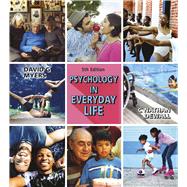Get the brief book that speaks to all students regardless of their background or level of preparedness. This, more than any other Myers/DeWall text, acknowledges the diversity of student readers. On these pages, you will find no assumptions about:
- Gender
- Culture
- Economic Background
- Education
- Physical Abilities
- Life Experiences
- Relationship or Family Status
Plus, this edition is heavily updated to reflect the latest in psychological science and to further emphasize the value of applying psychology to everyday life.








